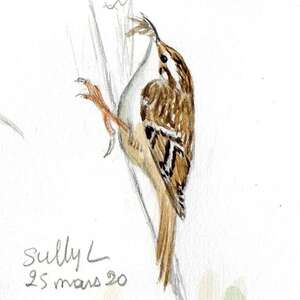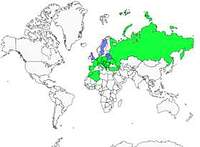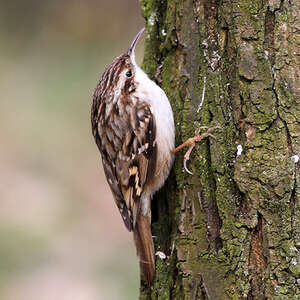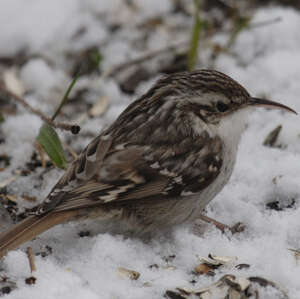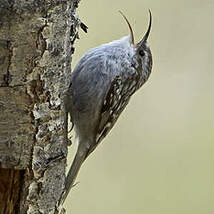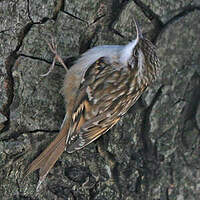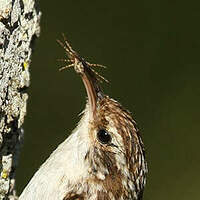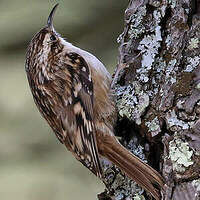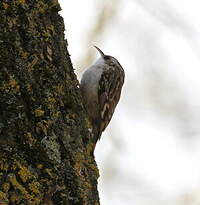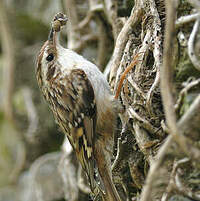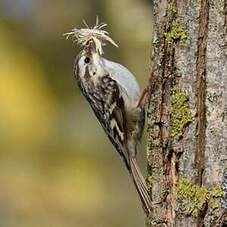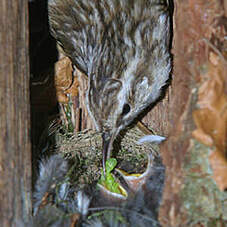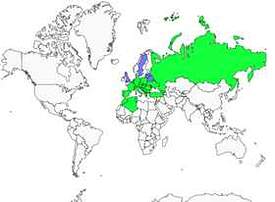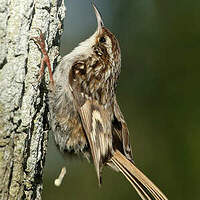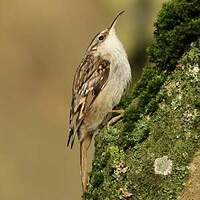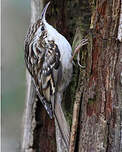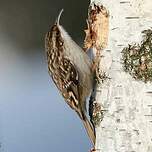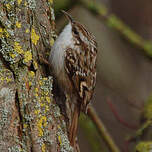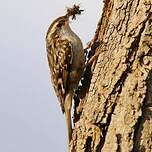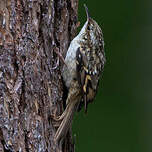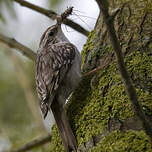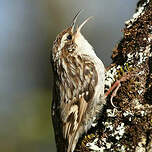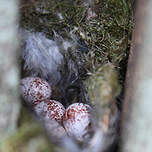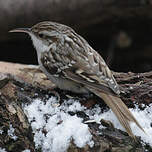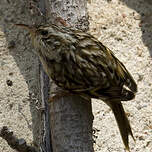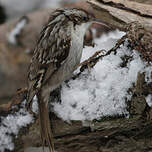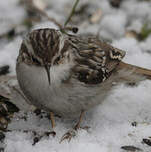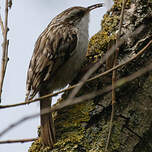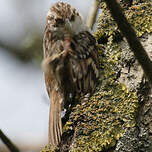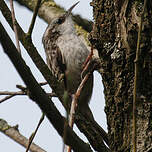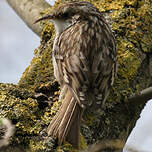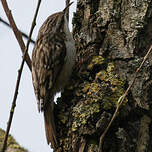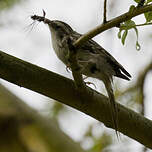Short-toed Treecreeper
Certhia brachydactyla - Grimpereau des jardins
Identification
Small birds, called treecreepers, have adapted very well to living in the trees, and more specifically on the bark. They move a bit like woodpeckers, up and down tree trunks and branches, using their tails to help them keep their balance. Their upper parts are very similar to the colour of tree bark - usually a medium brown, with markings of buckskin and dark brown. In Europe, there are two closely related species of treecreepers who co-exist. They are very similar in appearance and identification can be difficult. The best way to tell them apart is by their call (discussed in the next section). Another way is to look at the colour of their flanks, which are reddish-brown to grey-brown in the Short-toed Treecreeper and whitish to very faintly reddish in the Woodcreepers. The other, less obivous distinctions between the two species are the length of their beaks and the digiting on the hind toe. In the Short-toed Treecreeper, the beak is considered to be long while the claw is short, equal to or shorter than the toe. In the Woodcreepers, however, it is the opposite: the beak appears to be short while the claw is longer than the toe. This is easier to identify on photos. Finally, there are irrefutable wing pallet characters, but they require good profile photos or rear quarter views. Detailing them here would be tedious and probably incomprehensible. Please refer to the photos in the galleries to compare them.
Subspecific information 5 subspecies
- Certhia brachydactyla brachydactyla (s, c and se Europe from se Spain to Turkey)
- Certhia brachydactyla megarhynchos (w Europe from Portugal and nw Spain to w, n France and w Germany)
- Certhia brachydactyla mauritanica (nw Africa)
- Certhia brachydactyla dorotheae (s Greece, Crete and Cyprus)
- Certhia brachydactyla rossocaucasica (nw Caucasus)
Foreign names
- Grimpereau des jardins,
- Agateador europeo,
- trepadeira-do-sul,
- Gartenbaumläufer,
- rövidkarmú fakusz,
- Boomkruiper,
- Rampichino comune,
- trädgårdsträdkrypare,
- Kortklotrekryper,
- kôrovník krátkoprstý,
- šoupálek krátkoprstý,
- Korttået Træløber / Parktræløber,
- etelänpuukiipijä,
- raspinell comú,
- Garðfeti,
- pełzacz ogrodowy,
- īspirkstu mizložņa,
- kratkoprsti plezalček,
- Короткопалая пищуха,
- タンシキバシリ,
- 短趾旋木雀,
- trädgårdsträdkrypare,
- 短趾旋木雀,
Voice song and call
The song of the Short-toed Treecreeper is a brief (a little more than a second) stereotyped, sonorous and clear ritornello, that can be written as tit tit tiTuiutit. The call has the same tone of the song. It is a accented tjit repeated several times. We also hear siiih incisive when they move, that must not be confused with the finer and more incisive siiiiiih of the Short-toed Treecreeper. Finally we can note some tititi uttered on occasion as discreet contact cries.
Habitat
The Short-toed Treecreeper is originally a woodland bird associated with the deciduous lower altitude facies, particularly the old oaks.
Behaviour character trait
Short-toed Treecreepers are incredibly adapted to an exclusively arboreal lifestyle. They are the color of the bark they reside on, making them virtually invisible when not moving.
Very active, they move quickly and cling to tree bark with their four toes and sharp talons. Like woodpeckers, they use their rigid tails to steady themselves when they stop. Their habit is to inspect trees from bottom to top, from trunk to twigs. Unlike nuthatches, they cannot descend head-down and ascend again by flying. They rest attached vertically on a tree trunk or branch. This is also where they spend the night, fluffed-up with their head under its wing. Outside of the breeding season, they tend have a more solitary lifestyle. In winter, however, they will sometimes join flocks of tits, wrens and other nuthatches as they travel through forest habitats in groups to better protect themselves from predators and increase the efficiency of foraging.Flight
Dietfeeding habits
Short-toed Treecreepers search for their food on tree trunks and branches, carefully inspecting the bark and epiphytes for invertebrates and their resistant forms, all year round since they are sedentary. Their slender and curved beaks are not suitable for working the substrate but only for fitting into cracks in search of prey. These prey are mostly insects and spiders as well as the resistant forms of the former, eggs, larvae and pupae.
Reproduction nesting
The breeding season stretches from March to July, with of course an offset depending on the latitude and altitude.
In French lowlands, it reproduces from April to June. It has been proven that the Short-toed Treecreeper is occasionally polygamous. Most of the time, the Short-toed Treecreeper builds its nest behind the lifted bark of a dead or ailing tree. Any other recess, crack or crevice in a trunk or a branch can also do. It can also be in ivy along a trunk. The male builds several nest drafts and it is the female who makes her choice and finishes the work. The nest is at a variable height but mostly between 4 and 10 metres. It is made of twigs, herbs, pieces of bark and singular objects such as fabric or paper scraps. The interior of the nest is lined with rootlets, hair, feathers, moss and lichen. The female lays 5 to 7 eggs in it, white spotted with red-brown at the big end, which she will brood alone for 13 to 15 days. The young are fed in the nest by both adults 15 to 18 days after which they leave the nest, always surrounded by their parents' care. Usually a second brood follows. It can also happen that the two broods overlap. In such a case, the male finishes raising the youngster while the female is already preparing her second nest.Geographic range
The distribution area of the Short-toed Treecreeper extends over mainland Europe from the Atlantic to Poland, Ukraine, the shores of the Black Sea and Turkey. To the north, it is absent from the British Isles and the Scandinavian Peninsula. To the south, it occupies the reliefs of the extreme north of Africa. It is absent from the western Mediterranean islands, but not the eastern ones. The most eastern birds are in the Caucasus.
Threats - protection
IUCN conservation status
concern
in the Wild
threatened
evaluated
The Short-toed Treecreeper is generally a common species, therefore it is not threatened at present. However, it is locally rare in places such as the Caucasus. The species could suffer from deforestation due to climate change which directly affects the trees, such as summer droughts, and also from pests like the oak processionary moth which weaken already struggling trees. The risk is therefore the sanitary cut which abruptly deprives the treecreeper of its habitat.
Sources of information
- IOC World Bird List (v14.2), Gill, F and D Donsker (Eds). 2024-04-18.
- Les passereaux d'Europe, tome 2, P. Géroudet, M. Cuisin
- Birds of the World, The Cornell Lab of Ornithology
- xeno-canto, Sharing bird sounds from around the world,
Other sources of interest
 Specification sheet created on
15/07/2023 by Jean François
Specification sheet created on
15/07/2023 by Jean FrançoisTranslation by AI Oiseaux.net
© 1996-2025 Oiseaux.net
- Accipitriformes
- Aegotheliformes
- Anseriformes
- Apodiformes
- Apterygiformes
- Bucerotiformes
- Caprimulgiformes
- Cariamiformes
- Casuariiformes
- Charadriiformes
- Ciconiiformes
- Coliiformes
- Columbiformes
- Coraciiformes
- Cuculiformes
- Eurypygiformes
- Falconiformes
- Galliformes
- Gaviiformes
- Gruiformes
- Leptosomiformes
- Mesitornithiformes
- Musophagiformes
- Nyctibiiformes
- Opisthocomiformes
- Otidiformes
- Passeriformes
- Pelecaniformes
- Phaethontiformes
- Phoenicopteriformes
- Piciformes
- Podargiformes
- Podicipediformes
- Procellariiformes
- Psittaciformes
- Pterocliformes
- Rheiformes
- Sphenisciformes
- Steatornithiformes
- Strigiformes
- Struthioniformes
- Suliformes
- Tinamiformes
- Trogoniformes

